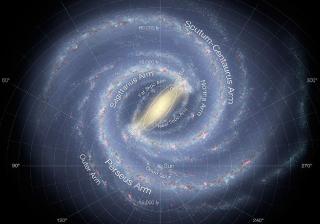Bibcode
Villar Martín, M.; Emonts, B.; Humphrey, A.; Cabrera Lavers, A.; Binette, L.
Referencia bibliográfica
Monthly Notices of the Royal Astronomical Society, Volume 440, Issue 4, p.3202-3219
Fecha de publicación:
4
2014
Número de citas
72
Número de citas referidas
68
Descripción
We have identified ionized outflows in the narrow-line region of all but
one Sloan Digital Sky Survey type 2 quasars (QSO2) at z≲0.1 (20/21,
detection rate 95 per cent), implying that this is a ubiquitous
phenomenon in this object class also at the lowest z. The outflowing gas
has high densities (ne≳1000 cm-3) and covers
a region the size of a few kpc. This implies ionized outflow masses
Moutf ˜ (0.3-2.4) × 106
M⊙ and mass outflow rates Ṁ< few
M⊙ yr-1. The triggering mechanism of the
outflows is related to the nuclear activity. The QSO2 can be classified
into two groups according to the behaviour and properties of the
outflowing gas. QSO2 in Group 1 (5/20 objects) show the most extreme
turbulence; they have on average higher radio luminosities and higher
excess of radio emission. QSO2 in Group 2 (15/20 objects) show less
extreme turbulence; they have lower radio luminosities and, on average,
lower or no radio excess. We propose that two competing outflow
mechanisms are at work: radio jets and accretion disc winds. Radio jet
induced outflows are dominant in Group 1, while disc winds dominate in
Group 2. We find that the radio jet mode is capable of producing more
extreme outflows. To test this interpretation, we predict that (1) high
resolution radio imaging will reveal the presence of jets in Group 1
QSO2; (2) the morphology of their extended ionized nebulae must be more
highly collimated and kinematically perturbed.
Proyectos relacionados

Morfología y dinámica de la Vía Láctea
El Proyecto se estructura en dos partes, diferenciadas pero complementarias: morfología y dinámica. El estudio detallado de la morfología de la Vía Láctea pretende proveer una base de datos de distribución estelar en las regiones más alejadas y extintas de nuestra Galaxia, mediante el desarrollo de modelos semiempíricos a partir de la información
Martín
López Corredoira